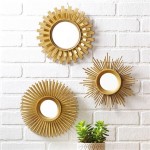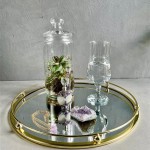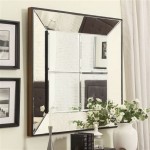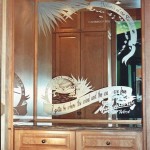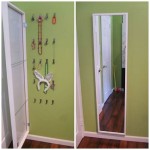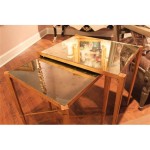Best Hardware For Hanging Mirrors
Selecting the appropriate hardware for hanging a mirror involves considering several factors, including the mirror's size, weight, and the wall's construction material. Choosing the correct hardware ensures the mirror's stability and prevents damage to both the mirror and the wall.
One of the most common hardware options for hanging mirrors is the D-ring hanger. D-rings are metal rings shaped like a "D" and are attached to the back of the mirror frame. They are typically used with picture wire and hooks or nails installed in the wall. D-ring hangers are suitable for medium to large-sized mirrors. The weight capacity of the D-rings should always exceed the weight of the mirror. It's essential to use heavy-duty picture wire rated for the mirror's weight.
Another popular choice is the wire hanger, which is often pre-installed on many mirrors. This system involves a wire stretched across the back of the mirror, attached with small loops or hooks, and designed to be hung on a single nail or hook. While convenient, wire hangers are generally recommended for lighter mirrors. Heavier mirrors may stress the wire and increase the risk of the mirror falling. Always inspect the existing wire for any signs of wear or damage and replace it if necessary before hanging.
J-hooks are also a viable option and are particularly well-suited for French cleats. French cleats are a two-part system consisting of a sloping piece of wood attached to the wall and a mating piece attached to the back of the mirror. The sloping surfaces interlock, providing a secure and stable hanging solution for heavy mirrors. J-hooks are then used to further secure the mirror to the cleat, preventing it from shifting or tilting. This system is particularly useful for very large or heavy mirrors where other hanging methods might be insufficient.
Mirror clips are another effective mounting method, especially for frameless mirrors. These clips typically consist of two parts: one attached to the wall and the other to the back of the mirror. The mirror then slides into the clips, securing it in place. Mirror clips offer a clean, minimalist look and are ideal for contemporary settings. They are available in various sizes and weight capacities to accommodate different mirror dimensions and weights.
Heavy-duty wall anchors are crucial when hanging mirrors, especially on drywall. These anchors provide a stronger hold than standard nails or screws by expanding within the wall cavity and distributing the weight more evenly. Several types of wall anchors are available, including toggle bolts, molly bolts, and screw anchors. Selecting the correct type depends on the wall's construction and the weight of the mirror. Always consult the weight rating on the anchor packaging to ensure it's appropriate for the application.
Adhesive hangers are a relatively new option for hanging mirrors. These products utilize a strong adhesive to bond the hanger directly to the wall and the back of the mirror. While convenient, adhesive hangers have weight limitations and are not suitable for all wall surfaces. It's essential to follow the manufacturer's instructions carefully and ensure the wall surface is clean and smooth before applying the adhesive. Adhesive hangers are generally recommended for lighter mirrors and may not be appropriate for areas with high humidity or temperature fluctuations.
When selecting hardware for hanging a mirror, the wall material plays a significant role. Drywall requires specific anchors to provide adequate support. For plaster walls, it's often recommended to use longer screws and potentially wall plugs to ensure a secure hold. Brick or concrete walls typically require drilling and the use of appropriate masonry anchors and screws. Identifying the wall type before selecting the hardware helps prevent installation issues and ensures the mirror's stability.
Proper installation is just as vital as selecting the right hardware. Always measure carefully to ensure the mirror is centered and level. When using D-rings and wire, the wire should be taut but not overly tight. For heavier mirrors, using two hanging points provides added stability and distributes the weight more effectively. Double-checking the installation and weight limits of the hardware minimizes the risk of the mirror falling and potentially causing damage.
Choosing the right hardware for hanging a mirror requires careful consideration of several factors. By evaluating the mirror's size and weight, the wall's construction, and the available hanging options, one can select the appropriate hardware to ensure the mirror's secure and stable placement.
Understanding the different types of hardware, their weight capacities, and their suitability for various wall types contributes to successful installation. Considering these aspects helps prevent damage to the mirror and the wall and ensures the mirror remains securely in place for years to come.
Safety should always be the top priority when hanging mirrors. Wearing appropriate safety glasses during installation protects the eyes from dust and debris. Using the correct tools and techniques ensures a secure and professional result. When in doubt, consulting a professional installer provides expert advice and ensures the mirror is hung safely and correctly.

How To Hang A Heavy Mirror The Home Depot

Glacier Bay Mirror Mounting Hanging Hardware Kit 805254 The Home Depot

Heavy Picture Mirror Hanging Kit 50 Kg

How To Hang A Heavy Mirror C R F T
How To Hang A 100 Pound Mirror On Drywall Quora

How To Hang A Large Or Heavy Mirror

How To Hang A Heavy Mirror Lowe S

Over The Door Hanging Mirrors A Comprehensive Guide

How To Hang Heavy Mirrors Frames Without Nails 3m

How To Hang A Heavy Mirror The Home Depot

